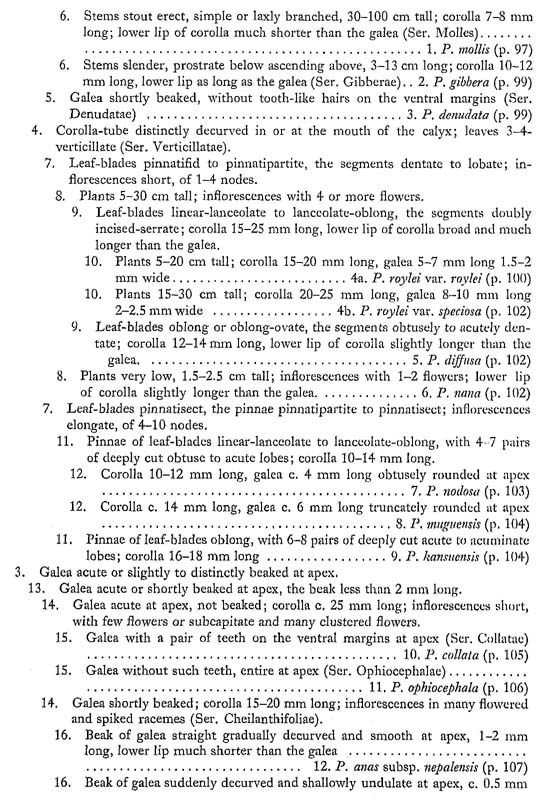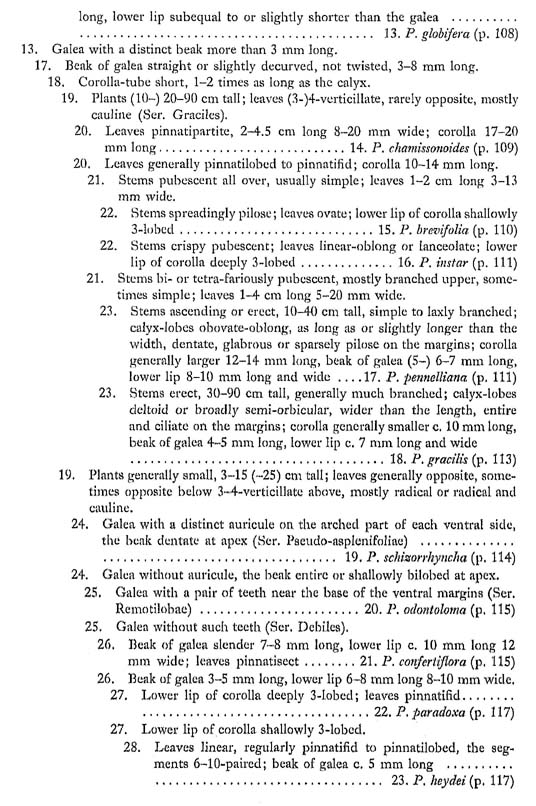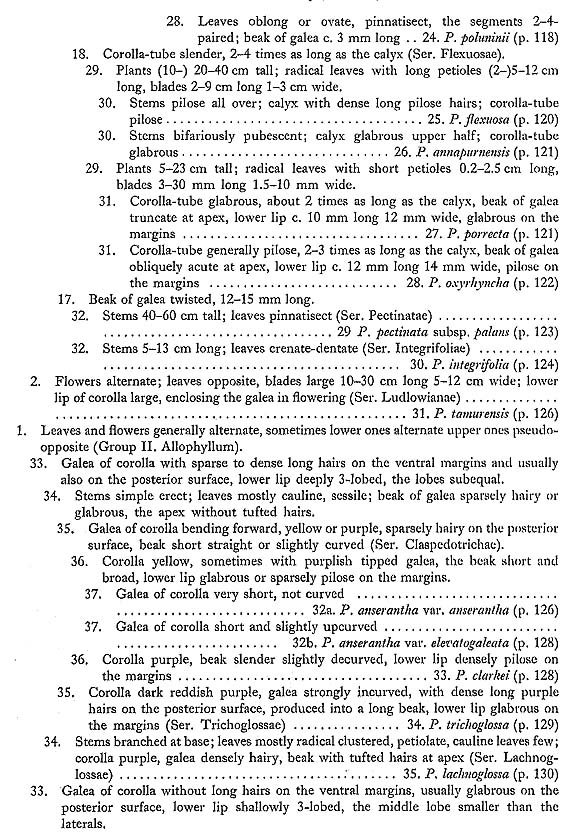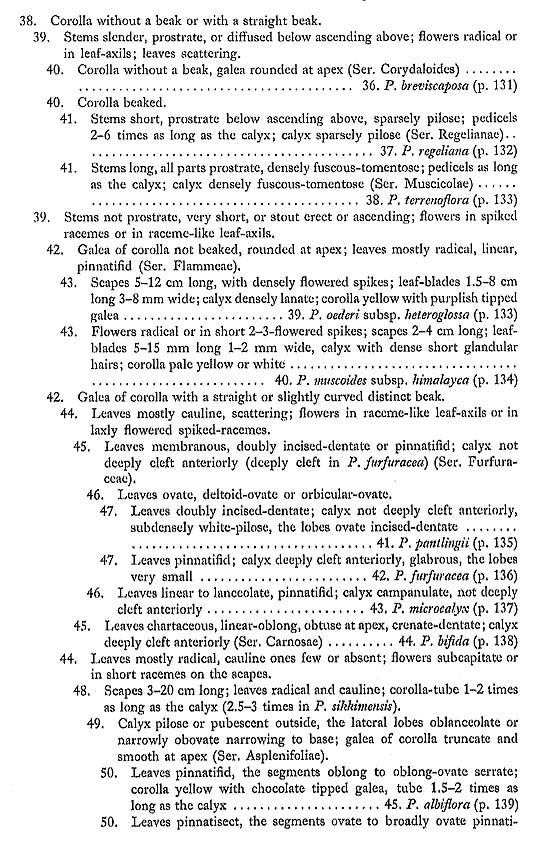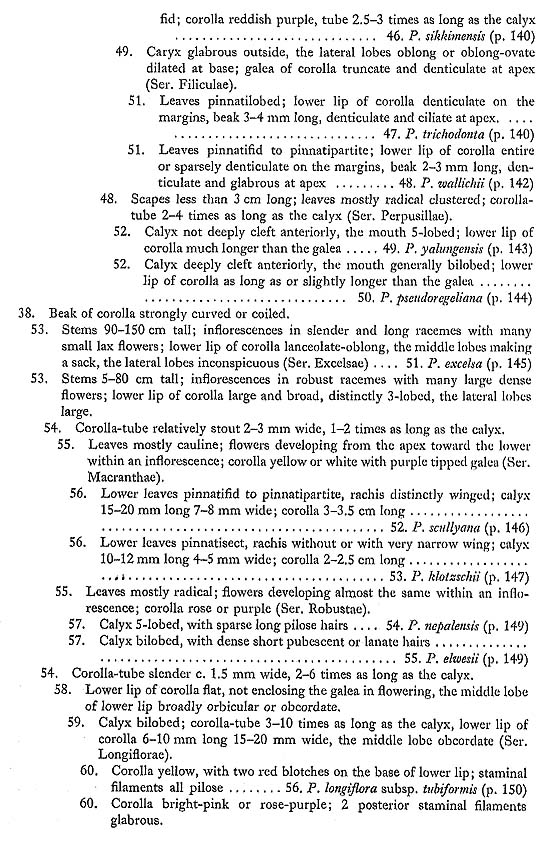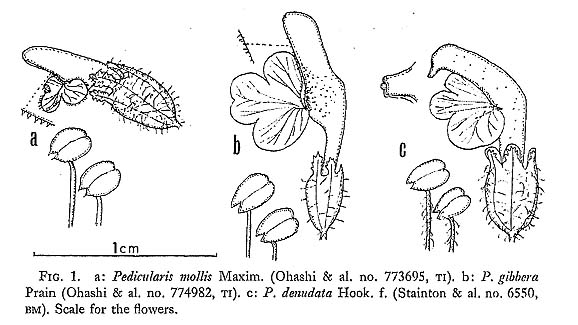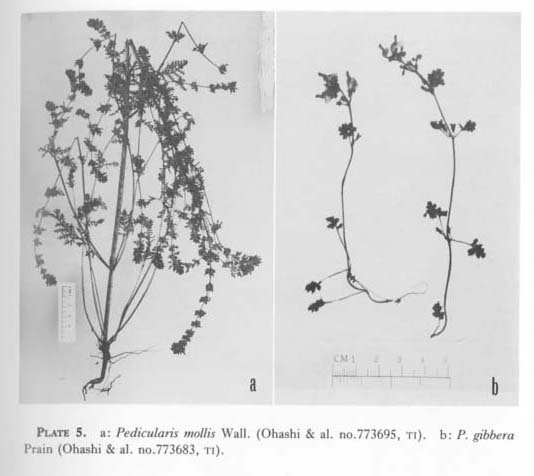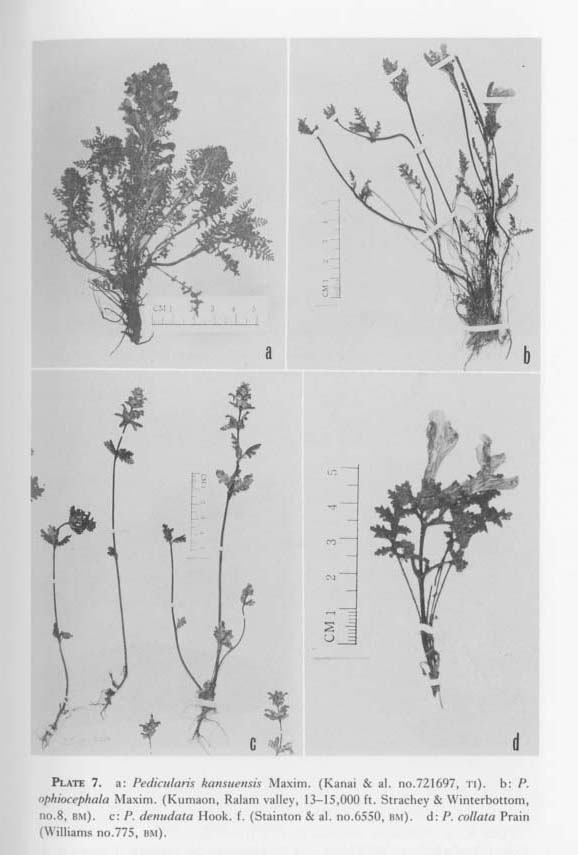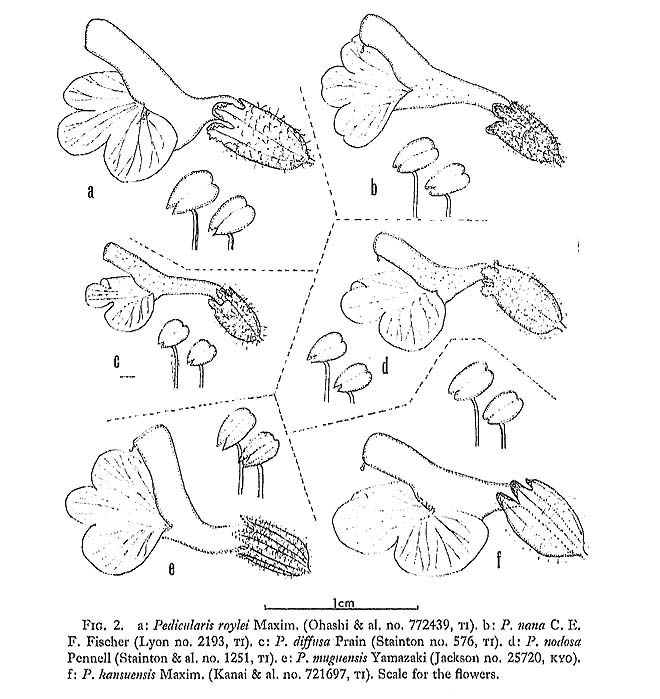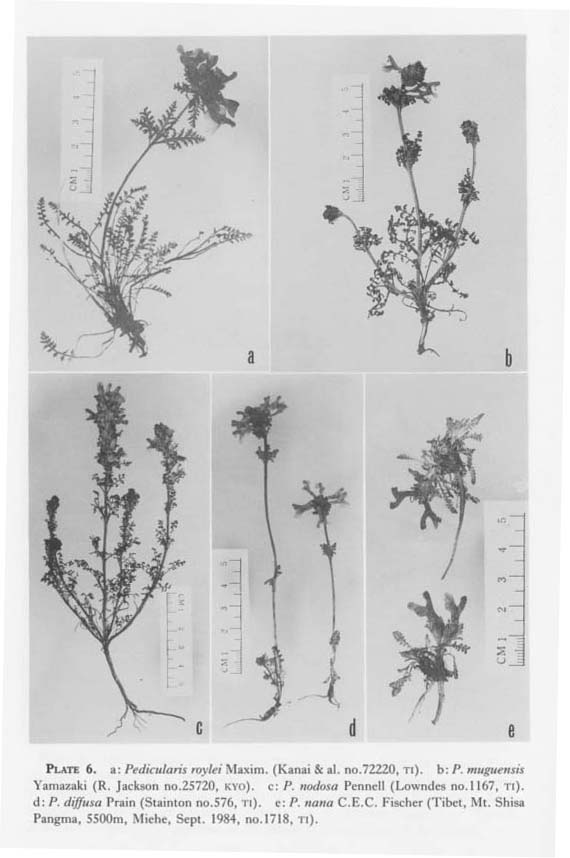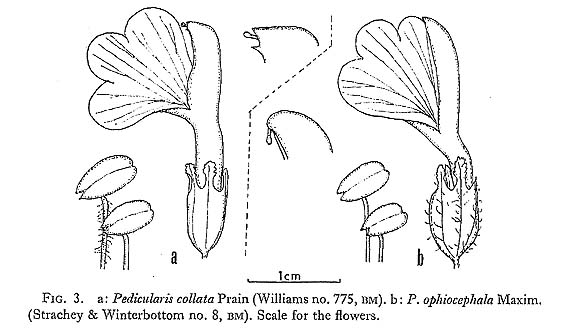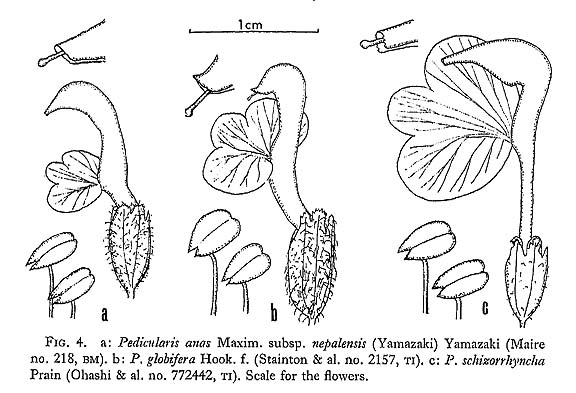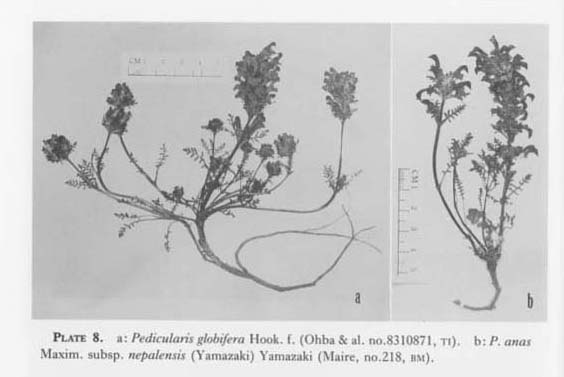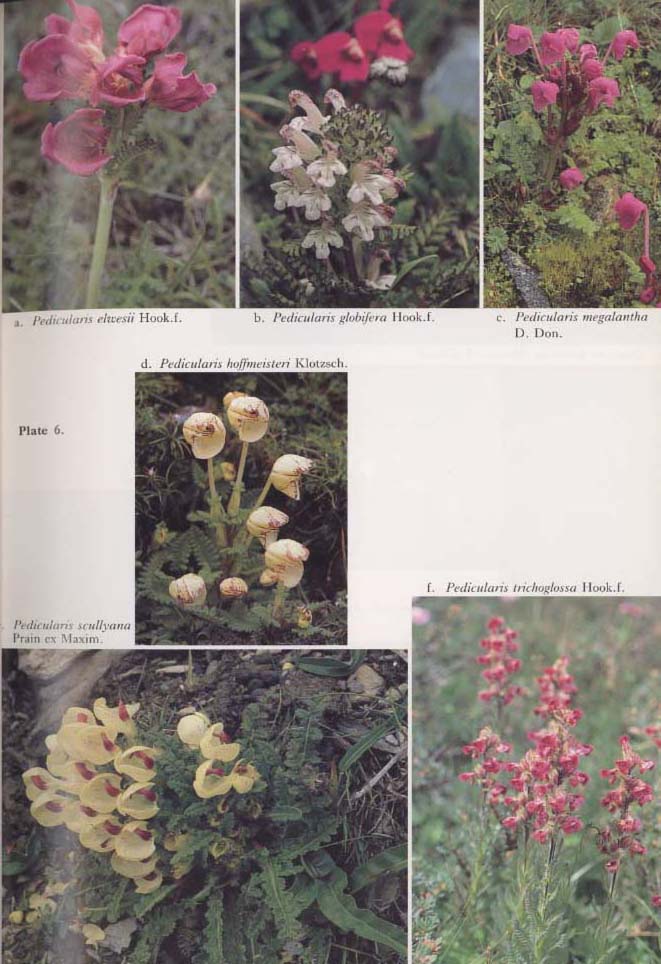A REVISION OF THE GENUS PEDICULARIS IN NEPAL
Takasi YAMAZAKI
| ( 1 / 4 ) |
|
The Himalayan Pedicularis (Scrophulariaceae) was extensively studied by Maximo wicz, Prain, Pennell and Tsoong. I have also been much interested in this genus and have studied it for many years. However, their taxonomy is still insufficient. Through botanical expeditions to Nepal and its adjacent areas by the British Museum, the Department of Medicinal Plants of Nepal, the University of Tokyo, and Kyoto University, a large number of excellent collections of the Himalayan Pedicularis have accumulated and I have had the opportunity to study these collections. In this paper I describe one new species and two new combinations of infraspecific taxa. As regards the infrageneric system of this genus, I propose five new sections and four new combination names of sections. In this revision I recognize 63 species from Nepal and provide a key to each series and species along with description, synonymy, notes of distribution and ecology, and specimens examined of each species together with photographs of representative specimens and line drawing of flowers. I am greatly indebted to the curators of the British Museum (Natural History) and Kyoto University for their loans of specimens. Pedicularis L.L., Sp. Pl., 607 (1753); Maxim, in Bull. Acad. Imp, Sci. St.-P é t. 24: 51-89 (1877), 32: 515-619, pls, 1-7 (1888); Hook. f. in Fl. Brit. Ind. 4; 306~317 (1884); Prain in Ann. Bot. Gard. Calcutta 3: 1-196, pls. 1-37 (1890); Bonati in Bull. Soc. Bot. France 57, Mem. 18: 1-35 (1910); Limpricht in Fedde, Rep. Sp. Nov. Veget. 20:161 265 (1924); Pennell in Monog. Acad. Nat. Sci, Philad. 5; 113-156, pls. 18-25 (1943); Li in Proc. Acad. Nat. Sci. Philad. 100: 205-378, pls. 15-23 (1948), 101: 1-214, pls. 1-16 (1949); Tsoong in Bull. Brit. Mus. (Nat. Hist.) Bot. 2: 1-34 (1955), in Act. Phytotax. Sin. 3: 273-333, pls. 34-44 (1954), 4: 71-147, pls. 7-29 (1955), 5: 205-278 (1956), in Fl. Reip. Pop. Sin. 68: 1-378, pls, 1-88 (1963); Yamazaki in Hara & al., Enum. Fl. Pl. Nepal 3: 119-126 (1982). Key to the series and the species
Group I. Cyclophyllum Li in Proc. Acad. Nat. Sci. Philad. 100: 256 (1948).Sect. 1. Orthosxphonia Li in Proc. Acad. Nat. Sci. Philad. 100: 263 (1948), p.p.Ser. 1. Molles Tsoongin Fl. Reip. Pop. Sin. 68; 201 (1963).1. Pedicularis mollis Wall. ex Benth. [Plate 5a, Fig. 1a]
Benth., Scroph. Ind., 53 (1835), in DC., Prodr, 10: 564 (1846); Hook.f. in Fl. Brit. Ind. 4: 309 (1884), in Bot. Mag. 116: t. 7132 (1890); Maxim. in Bull. Acad. Sci. St.-Pét. 32: 602, f, 126 (1888); Prain in Ann. Bot Gard. Calcutta 3: 176, t.29 A, f.1,-8 (1891); Pennell in Monogr, Acad, Nat. Sci. Philad. 5: 126 (1943); Tsoong in Fl, Reip. Pop. Sin. 68: 202, t.46, 1-3 (1963); Yamazaki in Hara & al,, Enum, Fl. Pl. Nepal 3; 124 (1982). Annual herbs 30-100 cm tall. Root straight, simple or few branched. Stems erect, simple or laxly branched, glabrous or sparsely pubescent lower, subdensely lanate upper. Leaves opposite or 3-4-verticillate; petioles 5-25 mm long, sparsely to sub densely pilose, lower leaves deciduous in flowering; blades ovate-oblong 1.5-5 cm long 0.8-2.5 cm wide, sparsely pilose on both surfaces, pinnatisect, the pinnae ovate oblong or oblong, pinnatilobed to pinnatifid, the lobes acute-serrate. Racemes terminal, elongate-spiciform, with many nodes having 2-4 flowers each. Bracts leaf-like, small, lanate. Pedicels 0.5-1 mm long. Calyx campanulate, 4-5 mm long 2.5 mm wide, pubescent, deeply 5-lobed, the posterior lobe linear-oblanceolate, entire c. 2 mm long, the lateral lobes oblanceolate, obtuse at apex, entire lower, crenate-dentate upper, c. 3 mm long 1 mm wide. Corolla rose, c. 8 mm long; tube straight, 3 mm long 1 mm wide, slightly bending above the calyx; galea straight, 3-4 mm long 1-1.2 mm wide, with small tooth-like hairs on the lower half of the ventral margins under the micro scope, rounded at apex; lower lip much shorter than the galea, c. 2 mm long and wide, pliose on the margins, 3-lobed, the lobes orbicular, c. 0.8 mm long 1 mm wide. Staminal filaments all glabrous. Anthers broadly elliptical, c. 1.2 mm long 0.9 mm wide, the cells apiculate at base. Capsule ovate acuminate, 6-7 mm long 3-4 mm wide. Distribution: Himalayas from Bashar to Bhutan and SE Tibet. Specimens examined. W NEPAL; Saipal (Arnold 1954, no. 72, BM), Chuchcmara pass, Rara, Mugu dist., 3800 m (Tabata & al. 1983, nos. 16651, 16755, KYO), Chutta, SE of Jumla, 10,000 ft. (Polunin & al., 1952, no. 4883, BM), Suli Gad, 10,000 ft. (Polunin & al. 1952, no. 2292, BM). C NEPAL ;Tukche, 2600m (Ohba & al., 1983, no. 8310329, TI), Muktinath, 12,900ft. (Shrester & Bista, no. 2426, TI), Thanti-Manang, 3900 m (Ohba & al. 1983, no. 8310817, TI), Manang-Humde (Ohba & al. 1983, no. 8350800, TI), Chilime Kharka, 13,500ft. (Polunin 1949, no. 1228, BM), Langtang Gorge-Langtang, 3100m (Kanai & Shakya 1970, no. 672470, TI), Langtang-Kyanging, 3700 m (Kanai & al, 1972, no. 670474, TI), Pangboche-peveche, 14,000 ft. (Baneji & Shakya no. 5697, BM, TI), Beding-Na, Rolwaling Khola, 3600-4000 m (Ohba & al. 1983, no. 8351297, Tl). E NEPAL; Piling La-Thudam, 3500 m (Ohashi & al. 1977, no. 773695, TI), Tasagon-Topke Gola, 3800 m (Ohashi & al. 1977, no. 770868, TI), Nup-Yangma, Taplejung dist., 3800-4000 m (Tabata & al. 1978, no. 11814, KYO, TI). Ser. 2: Gibberae Prain in Ann. Bot. Gard. Calcutta 3: 96 (1891), p.p.2. Pedicularis gibbera Prain [Plate 5b, Fig. 1b] Prain in J. As. Soc. Bengal 58: 262 (1889), in Ann. Bot. Gard. Calcutta 3: 174,t.29B, f. 9-16 (1891); Limpricht in Fedde, Rep. Sp. Nov. Veget. 20: 209 (1924); Tsoong in Bull. Brit. Mus. (Nat. Hist.) Bot. 2: 32 (1955);Yamazaki in Hara & al., Enum. Fl. Pl. Nepal 3: 123 (1982). Weak perennial herbs 3-13 cm long. Roots fibrous fleshy, crown covered by several scales and with small buds. Stems slender prostrate below, ascending above, bifariously pubescent. Leaves membranous, opposite; petioles 3-15 mm long, glabrous or sparsely pilose; blades ovate, 5-13 mm long 3-8 mm wide, sparsely white-pilose on both sur faces, pinnatilobed, the segments ovate, acutely incised-serrate. Flowers solitary axillary. Pedicels 1-2.5 mm long, pilose. Calyx campanulate, membranous, c. 3 mm long 1 mm wide, sparsely pilose, 5-lobed, the posterior lobe setaceous, the lateral lobes ovate-oblong, c. 1 mm long 0.5 mm wide, acute-serrate. Corolla white, 1-1.2 cm long; tube straight 5 mm long 1 mm wide, about 1.5 times as long as the calyx, glabrous, bending at the junction of tube and galea; galea straight, 5 mm long 1 mm. wide glan dular punctate on the hood, with tooth-like hairs on the ventral margins under the microscope, rounded at apex; lower lip as long as the galea, c, 5 mm long and wide, 3-lobed, the middle lobe broadly orbicular, emarginate, 2,5 mm long 3 mm wide, the lateral lobes reniform, c. 3 mm long and wide, glabrous on the margins. Staminal fila ments all glabrous. Anthers elliptical, c. 1.2 mm long 0.6 mm wide, the cells subacute at base. Capsule lanceolate attenuatcly acuminate 6-7 mm long 2 mm wide. Distribution: Himalayas from Nepal to Bhutan. Specimens examined: E NEPAL; Chhurchathanga-Piling La, 3600-3700 m (Ohashi & al. 1977, nos, 770681, 773683, 773685, 774982, TI). Ser. 3. Denudatae Prain in Ann. Bot. Card, Calcutta 3: 96 (1890), p.p.; Taoong in Fl. Reip. Pop. Sin. 68: 202 (1963).3. Pedicularis denudata Hook, f. [Plate 7c, Fig. 1c]
Hook. f. in Fl. Brit. Ind. 4; 309 (1884); Prain in Ann. Bot. Gard. Calcutta 3; 176, t. 29D (1890); Yamazaki in Hara & al., Enum. Fl, Pl. Nepal 3: 122 (1982). Annual herbs 9-30 cm tall. Roots straight with many rootlets. Stems slender simple erect, quadri-fariously and sparsely pubescent. Leaves 4-verticillate; petioles 1-3 mm long, sparsely pilose; blades oblong, obtuse at apex, 10-20 mm long 6-12 mm wide, pilose on both surfaces, pinnatifid, the lobes 3-5-paired, oblong, obtuae at apex, dentate. Bracts leaf-like, sessile. Inflorescences spiked, with 2-6 interrupted nodes having 4 flowers each. Flowers sessile. Calyx broadly campanulate, membranous, 3-4 mm long 2.5-3 mm wide, densely pilose, 5-lobed, the lobes ovate-oblong, 1-1.5 mm long, dentate, reflexed at margins, Corolla pale purple-red; tube straight, c. 5 mm long 1.5 mm wide, glabrous; galea abruptly deflcxed at base, arched near the apex, c. 5 mm long 1.5 mm wide, glabrous, shortly beaked at apex; lower lip shorter than the galea, c. 4 mm long 5 mm wide, glabrous on the margins, 3-lobed, the middle lobe orbicular c. 1,5 mm long and wide, the lateral lobes reniform c. 3 mm wide. Staminal filaments all pilose. Anthers elliptical, c. 1 mm. long 0.6 mm wide, the cells acute at base. Distribution: C Nepal and Sikkim. Specimens examined: C NEPAL; Annapurna Himal., Seti Khola, 13,000 ft. (Stainton & al. 1954, no. 6550, BM). Sagarmatha zone, Solukhumbu dist. Thosa Kharka-Beni Kharka, 3600-4300 m (Ohba & al. 1985, no. 8571932, TI). Sect. 2. Sigmantha Li in Proc. Acad. Nat. Sci. Philad. 100: 299 (1948), p.p.Ser. 4. Verticillatae Maxim, in Bull. Acad. Sci, St.-Pét. 24: 61 (1877), p.p., 32: 590 (1888); Prain in Ann. Bot. Gard. Calcutta 3: 94 (1890); Li in Proc. Acad. Nat. Sci. Philad. 100: 300 (1948); Tsoong in Fl. Reip. Pop. Sin. 68: 152 (1963).4. Pedicularis roylei Maxim. [Plate 6a, Fig. 2a]
Maxim, in Bull. Acad. Sci. St.-Pét. 27: 517 (1881), 32: 597, f.122 (1888); Prain in Ann. Bot. Gard. Calcutta 3: 173, t.33 B, f.5-11 (1890); Limpricht in Fedde, Rep. Sp. Nov. Veget. 20: 207 (1924); Pennell in Monogr. Acad. Nat. Sci. Philad, 5: 119 (1943); Li in Proc. Acad. Nat. Sci. Philad. 100: 321, t.46 (1948); Tsoong in Fl. Reip. Pop. Sin. 68: 157, t.31, 1-3 (1963); Yamazaki in Hara & al., Enum. Fl. Pl. Nepal 3: 115 (1982). Perennial herbs 5-20 cm tall. Roots simple or several, fleshy elongate-fusiform descending from the woody crown covered by withered petioles and membranous scales. Stems many branched at base, clustered, simple, erect or ascending, sometimes prostrate below, with sparse to dense long pilose hairs. Leaves opposite below clustered, 3-4-verticillate upward; petioles 1-4 cm long, glabrous or white-pilose; blades linearlanceolate to lanceolate-oblong, 0.8-3 cm long 2-7 mm wide, glabrous or white-pilose on both surfaces, pinnatifid to pinnatipartite, rachis winged, the pinnae 6-10-paired oblong or oblong-lanceolate, acute at apex, doubly and acutely incised-serrate. Racemes terminal, of 2-5 clustered nodes having 4 flowers each. Bracts leaf-like, as long as or longer than the calyx, petioles broad, with long white pilose hairs on the margins. Pedicels 0.5-4 mm long. Calyx membranous, tubular or tubular-campanulate, villose, with 5 prominent veins, 5-lobed, the posterior lobe small setaceous, the lateral lobes obovateoblong, 2-3 mm long 1-1,5 mm wide, entire below, acute-serrate above. Corolla reddish purple, 1.5-2 cm long, sparsely glandular-punctate under the microscope; tube decurved at the mouth of the calyx, 10-13 mm long 2-3 mm wide; galea slightly arched, 5-7 mm. long 1.5-2 mm wide, truncate at apex; lower lip longer than the galea, 7-8 mm long 8-10 mm wide, glabrous on the margin, 3-lobed, the middle lobe orbicular, 3-4 mm long 2.5-3 mm wide, the lateral lobes reniform 6-7 mm wide. Staminal filaments all glabrous. Anthers elliptical, c. 2 mm long 1.2mm wide, the cells acute at base. Distribution: Himalayas from Hazara to Bhutan, SE Tibet and W China. Specimens examined: W NEPAL; Kariganga-Aletsoura, near Saipal (Tabata & al. 1976, no. 1865, TI KYO), Nangja La, Mugu dist., 4850m (Tabata & al. 1983, no. 17815, KYO). C NEPAL; Tegar, N. of Mustang, 15,000 ft. (Stainton & al. 1954, no. 2226,BM), Throng Phedi, Mustang dist., 4000 m (Ohba & al. 1983, no. 8330802, TI), Shiar Khola-Changyan Khola, 16,500 ft. (Gardner 1953, no. 719, BM). E NEPAL; Arun valley, Barun Khola, N of Num, 12,500 ft. (Stainton 1956, no. 631, BM), Yalung Kharka-Pam Lhang, Rolwaling dist., 4300-4700 m [Ohba & al. 1983, no. 8351365, TI), Gosa near Kobche, 4100 m (Kanai & al. 1972, no. 720389, TI), Saju Pokhari-Topke Gola, 4000-4400 m (Kanai & al. 1972, no. 72220, TI), Topke Gola-Julang Chhyongo, 4000 m (Kanai & al. 1972, no. 720628, TI), Topke Gola, 15,000 ft. (Shresta 1971, no. 463, BM), Janga La, 4450 m (Kanai & al. 1972, no. 72219, TI), Khang La-Thangje, Taplejung dist., 4730m (Tabata & al. 1978, no. 11615, TI, KYO), around Lamni Nama, 4200-4900 m (Ohashi & al. 1977, no. 772439, TI). 4b. var. speciosa (Prain) Yamazaki, stat. nov. Pedicularis roylei Maxim. subvar. speciosa Prain in Ann. Bot. Gard. Calcutta 3: 173, t. 33 C (1891). Plants stout 15-30 cm tall. Leaves large; petioles 1-6 cm long; blades 10-20 mm long, pinnatifid, rachis broadly winged. Corolla 20-25 mm long; galea 8-10 mm long 2-2.5 mm wide; lower lip c. 10 mm long 15-20 mm wide. Distribution: Himalayas from W Nepal to Sikkim and SE Tibet. Materials: W NEPAL; Ccheti, 12,000 ft. (Stainton 1965, no. 4959, BM, TI), NE of Saipal, 18,000 ft. (Arnold 1954, Type of P. saipalensis, BM). C NEPAL; Lamjung Himal., 17,500 ft. (Stainton & al. 1954, no. 6276, BM), Kalum Salbu pass, 3800 m (Nakao 1953, Type of P. rupicoloides, KYO). E NEPAL; Arum-Tamur, S of Topke Gola, 14,000 ft. (Stainton 1956, no. 850, BM), Thudam-Lamni Nama, 4000 m (Ohashi & al. 1977, no. 770771, TI). 5. Pedicularis diffusa Prain [Plate 6d, Fig. 2c] Prain in J. As. Soc. Bengal 62: 7, t.l (1893); Limpricht in Fcdde, Rep. Sp. Nov. Veget. 20: 204 (1924); Tsoong in Fl. Reip. Pop. Sin. 68: 185, t.40, 1-4 (1963); Yamazaki in Hara & al., Enum. Fl. Pl. Nepal 3: 122 (1982). Perennial herbs 6-15 cm tall. Root simple straight, fleshy, fusiform, with several fibrous rootlets. Stems erect, simple, tetrafariously pubescent. Leaves 4-verticillate; petioles 2-7 mm long, white-pilose; blades oblong or ovate-oblong, 5-10 mm long 2-5 mm wide, sparsely white-pilose on both surfaces, pinnatipartite, rachis narrowly winged, the pinnae ovate-oblong, acute-serrate reflexed on the margins. Racemes terminal, of 2-4 clustered nodes having 4 flowers each. Bracts leaf-like, as long as or slightly longer than the calyx. Flowers subsessile. Calyx membranous, tubular-campanulate, c. 4 mm long 2 mm wide, white-pilose, 5-lobed, the posterior lobe small setaceous, acute at apex, entire, the lateral lobes oblong-ovate, c, 1.5 mm long 1 mm wide, acute-serrate. Corolla pink, 12-14 mm long, sparsely glandular-punctate under the microscope; tube decurved at the mouth of the calyx, c, 7 mm long 1.5mm wide, about 2 times as long as the calyx; galea straight, 3.5 mm long 1.2 mm wide truncate at apex; lower lip c. 4 mm long 7 mm wide, slightly longer than the galea, glabrous on the margins, 3-lobed, the middle lobe orbicular, c. 2 mm long and wide, the lateral lobes broadly orbicular, c. 3 mm wide. Stamens; 2 anterior filaments pilose, 2 posterior ones glabrous; anthers elliptical, c. 1 mm long 0.6 mm wide, the cells acute at base. Distribution: Himalayas; E Nepal, Sikkim and SE Tibet. Specimens examined: C NEPAL; Langtang, Yala, 4800-4960 m (Miehe 1986, nos. 4927, 5309, TI), Langtang, Tikeapsa, 4500m (Miehe 1986, no. 4021, TI). E NEPAL; Arun valley, Barun Khola, N of Num, 11,000 ft. (Stainton no. 1956, 576, BM, TI). 6. Pedicularis nana C. E. C. Fischer [Plate 7e, Fig. 2b] C. E. C. Fischer in Kew Bull. 1940: 190 (1940); Tsoong in Bull. Brit. Mus. (Nat. Hist.) Bot. 2: 33 (1955), in Act. Phytotax. Sin. 3: 332 (1955); Yamazaki in Hara & al., Enum. Fl. Pl. Nepal 3: 124 (1982). Perennial herbs 1.5-2.5 cm tall. Roots several fleshy, elongate-fusiform, descending from the crown covered by withered petioles. Stems very short, c. 1 cm long. Leaves mostly radical, opposite below, 4-verticillate above; petioles 2-8 mm long, with white long pilose hairs on the margins; blades linear-oblong, obtuse at apex, 4-10 mm long 1.5-3 mm wide, sparsely white-pilose on both surfaces, pinnatifid, the segments 5-7-paired oblong or oblong-ovate, acute-serrate, reflexed at margins. Racemes terminal, subcapitate, 2-4-flowered. Bracts leaf-like with broad petioles, longer than the calyx. Pedicels 1-2 mm long. Calyx tubular-campanulate, membranous, with 10 dark veins, c. 5 mm long 2.5 mm wide, villose, 5-lobed, the posterior lobe small setaceous, the lateral lobes ovate or oblong-ovate, c. 1.5 mm long 1 mm wide, acute-serrate, reflexed at margins. Corolla reddish purple, c. 15 mm long; tube decurved at the mouth of the calyx, c. 10mm long 2 mm wide, glabrous below sparsely glandular-punctate upper under the microscope; galea straight, c. 5 mm long 1.5 mm wide, truncately rounded at apex; lower lip longer than the galea, c. 6 mm long 9 mm wide. glabrous on the margins, 3-lobed, the middle lobe orbicular, emarginate, c. 2.5 mm long 3 mm wide, the lateral lobes broadly orbicular, emarginate, c. 3.5 mm wide. Staminal filaments all glabrous; anthers elliptical, c. 1.8 mm long 1.2 mm wide, the cells obtuse at base. Distribution: C Nepal, Bhutan, S Tibet and N Burma. Specimens examined: C NEPAL; Langtang, above Tangsep 4760m (Miehe 1986, nos. 10691, 10724, TI). Rolwaling, 17,800 ft. (Lyon 1964, no. 2193, BM, TI). 7. Pedicularis nodosa Pennell [Plate 7c, Fig. 2d] Pennell in Monogr. Acad. Nat. Sci. Philad. 5: 119, t.18B (1943); Yamazaki in J. Jap. Bot. 45: 170 (1970), in Hara & al., Enum. Fl. Pl. Nepal 3: 124 (1982), in J. Jap. Bot. 61: 300 (1986). Annual herbs 10-20 cm tall. Root simple or a few branched. Stems branched at base, erect or ascending, simple, tetrafariously pubescent. Leaves generally 4-, sometimes 3- or 5-verticillate; petioles 3-10 mm long, white-lanate; blades lanceolate, 1.5-2cm long 5-12 mm wide, pinnatisect, rachis winged, white-pilose, the pinnae 4-6-paired, linear-lanceolate, sparsely white-pilose, acutely incised-serrate, Inflorescences terminal, with 2-4 nodes having 4 flowers each. Bracts leaf-like smaller. Pedicels 1-2 mm long. Calyx membranous, urceolate-tubular, with 10 dark veins, 4 mm long 3 mm wide, densely white-villose, 5-lobed, the lobes ovate, 1-2 mm long 1 mm wide, acuteserrate. Corolla pinkish white, 10-12 mm long; tube decurved at the mouth of the calyx, 7-8 mm long 1.5-2 mm wide, longer than the calyx; galea straight, 4 mm long, glabrous, obtusely rounded at apex; lower lip longer than the galea, c. 5 mm long 8 mm wide, glabrous on the margins, 3-lobed, the middle lobe orbicular, 3 mm. long and wide, the lateral lobes semicircular, c. 4mm wide. Stamens; 2 anterior filaments pilose, 2 posterior ones glabrous; anthers elliptical, c. 1.4 mm long 0.8 mm wide, the cells, acute at base. Capsule lanceolate-oblong, acute at apex, 12-13 mm long 4mm wide, 1.5-2 times as long as the calyx. Distribution: Himalayas from Almora to C Nepal and S Tibet. Specimens examined: C NEPAL; Thinigaon, Muktinath Himal., 11,500 ft. (Stainton & al. 1954, no. 1251, BM, TI), Mustang, 14,000 ft. (Stainton & al. 1954, no. 2390, BM, TI), Marsiandy valley, 11,500 ft. (Lowndes 1950, no. 1167, BM, TI), Phokusund Khola, 12,000 ft. (Shresta 1966, no. 5355, TI), Jharkot-Muktinath, 3400 m (Ohba & al. 1983, no. 8310624, TI), Manang-Humde, 3300-3500 m (Ohba & al. 1983, no. 831110, TI). 8. Pedicularis muguensis Yamazaki, sp. nov. [Plate 6b, Fig. 2e] Annual herbs 8-17 cm tall. Root simple straight, with few rootlets. Stems few branched at base, erect, simple, densely and subtetrafariously white-pubescent. Leaves 4-verticillate; petioles 2-10 mm long, gradually shorting above, sparsely white-pilose; blades lanceolate to lanceolate-oblong, 6-20 mm long 2-5 mm wide, sparsely pilose on both surfaces, pinnatisect, rachis not winged, the pinnae 5-7-paired, lanceolateoblong, acute at apex, acutely incised-serrate or pinnatilobed. Inflorescences terminal, of 3-5 fascicules having 4 flowers each. Bracts oblong-ovate, leaf-like, petioles broad covering the calyx densely white-pilose, as long as or longer than the calyx. Pedicels 0.5-1.5 mm long, pilose. Calyx tubular-campanulate, membranous, c. 6 mm long 3 mm wide, with 10 prominent veins, densely white-lanate, 5-lobed, the lobes lanceolate, acute at apex, c. 1 mm long 0.5 mm wide, acute-serrate, reflexed at margins. Corolla pinkish purple, c. 14mm long; tube c. 8 mm long 2 mm wide, glabrous, longer than the calyx, decurved at the mouth of the calyx; galea straight, c. 6 mm long 2 mm wide, sparsely glandular-punctate under the microscope, truncately rounded at apex; lower lip c. 7 mm long 8 mm wide, slightly longer than the galea, glabrous on the margins, 3-lobed, the middle lobe orbicular, c. 3 mm long and wide, the lateral lobes semiorbicular, c. 4 mm wide. Staminal filaments all glabrous. Anthers elliptical, c. 1.8 mm long 1 mm wide, the cells acute at base. Herba annua 8-17 cm alta. Folia 4-verticillata, lanceolata vel lanceolato-oblonga, 6-20 mm longa 2-5 mm lata, pinnatisecta, pinnis lanceolato-oblongis inciso-serratis vel pinnatilobatis. Inflorescentiae spiciformes, floribus 4-verticillatibus. Calyx tubulosocampanulatus, membranaceus, 6 mm longus 3 mm latus, dense albo-lanatus, prominente 10 costatus, 5-lobatus. Corolla c. 14 mm longa, tubo supra basin geniculato, galeo recto apice truncato-rotundato, labio infero galeo leviter longiore 3-lobato, filamentis staminum glabris. P. nodosa Pennell poxime affinis, sed a qua galeis corollarum longioribus apice truncato-rotundatis differt. Distribution: NW Nepal. Specimens examined: W NEPAL; Eding, Mugu dist., 82°34' E, 29°33' N, on the south side of the Langu river, 3600m (Rodeney Jackson, June 3, 1984, no, 25720, Holotype KYO, Isotype TI), Tillisha, Mugu dist., 82°35' E, 29°35' N, on the north side of the Langu river (R. Jackson, June 17, 1984, no. 25822, KYO). 9. Pedicularis kansuensis Maxim. [Plate 7a, Fig. 2f] Maxim. in Bull. Aca. Sci. St.-P é t. 27: 516 (1881), 32: 596, f. 116 (1888); Limpricht in Fedde, Rep. Sp. Nov. Veget. 20: 208 (1924); Li in Proc. Acad. Nat. Sci. Philad. 100: 318, f. 44 (1948); Tsoong in Act. Phytotax. Sin. 3: 332 (1955), in Fl. Reip. Pop. Sin. 68: 167 (1963); Yamazaki in J. Jap. Bot. 45: 167 (1970), in Hara & al., Enum. Fl. Pl. Nepal 3: 123 (1982). Pedicularis verticillata L. var. chinensis Maxim. 1.c. 24: 63 (1877). Annual herbs 10-50 cm tall. Stems branched at base, simple, white-pubescent. Leaves opposite below, 4-verticillate above; petioles 4-13 mm long with white long pubescent hairs; blades lanceolate-oblong, 1-2.5 cm long 5-8 mm wide, glabrescent or sparsely pilose, pinnatisect, rachis not winged, the pinnae 6-8-paired, oblong, acute to acuminate at apex, deeply serrate, the serrations acute callous. Inflorescences terminal, of 4-12 fascicules having 4 flowers each. Bracts ovate to lanceolate, petioles broad pilose on the margins, blades leaf-like. Pedicels 0.5-2 mm long. Calyx membranous, urceolate-campanulate, with 10 dark veins, 7-8 mm long 4-5 mm wide, sparsely long-pilose, 5-lobed, the posterior lobe small, linear, acuminate, the lateral lobes ovate, c. 2 mm long 1-1.5 mm wide, acute-serrate, reflexed on margins. Corolla pale violet, 16-18 mm long, glabrous; tube 8-10 mm long 2-3 mm wide, longer than the calyx, decurved at the mouth of the calyx; galea straight, c. 5 mm long 1.8 mm wide, truncately rounded at apex; lower lip longer than the galea, c. 7 mm long 15 mm wide, 3-lobed, the middle lobe orbicular, c. 5 mm long and wide, the lateral lobes reniform, c. 7 mm wide, glabrous on the margins. Staminal filaments all glabrous. Anthers elliptical, c. 1.5mm long 0.8mm wide, the cells obtuse at base. Capsule lanceolate attenuate-acuminate, c. 15 mm long 5 mm wide. Distribution: E Nepal, SE Tibet and W China. Specimens examined: E NEPAL; Thudam-Lama Chungbu, 4160 m (Kanai & al. 1972, no. 721697, TI), Nud-Yangma, Taplejung Distr., 3800-4000 m (Tabata & al. 1978, no. 11811, KYO, TI), Yangma, 4500 m (Nakao 1962, no. 55, KYO), Nouma, 4100 m (Nishida 1962, no. 176, KYO), Nipal, near Sangda, 3700 m (Nishioka 1958, no. 540, KYO). Sect. 3. Brachystachys (Tsoong) Yamazaki, stat. nov.Grex Dolichophyllum Subgrex Brachystachys Tsoong in Fl. Reip. Pop. Sin, 68: 304 (1963). Ser. 5. Collatae Prain in Ann. Bot. Gard. Calcutta 3: 97 (1890); Limpricht in Feddc, Rep. Sp. Nov. Veget. 20: 212 (1924); Tsoong in Fl. Reip. Pop. Sin. 68: 304 (1963).10. Pedicularis collata Prain [Plate 7d, Fig. 3a]
Prain in J. As. Soc. Bengal 58: 266 (1889), in Ann. Bot. Gard. Calcutta 3 :144, t. 31 C (1890); Tsoong in Bull. Brit. Mus. (Nat. Hist.) Bot. 2: 32 (1955); Yamazaki in Hara & al., Enum. Fl. Pl. Nepal 3: 122 (1982). Weak perennial herbs 3-7 cm tall. Roots several, fleshy, descending from the crown covered by membranous oblong scales. Stems branched at base, simple, erect, glabrous. Leaves opposite; petioles 1-3 cm long, glabrous; blades oblong-lanceolate, 10-20 mm long 6-13 mm wide, glabrous, pinnatisect, rachis winged, the segments 4-5-paired, oblong to ovate-oblong, doubly and acutely incised-serrate. Racemes terminal, 1-3-flowered. Pedicels c. 1 mm long, glabrous. Calyx membranus, tubular-campanulate, c. 8 mm long 4 mm wide, glabrous, 5-lobed, the posterior lobe linear, entire, 2-3 mm long 0.8 mm wide, 4-lateral lobes oblong, dilated and dentate above, entire below, 3-4 mm long c. 1.5 mm wide. Corolla pink, c. 25 mm long; tube straight, c. 15 mm long 3 mm wide, sparsely pilose; galea straight, c. 10 mm long 3 mm wide, arched at apex, with a pair of teeth at the ventral apical parts; lower lip large, c. 12 mm long 15mm wide, slightly longer than the galea, glabrous on the margins, 3-lobed, the middle lobe orbicular, c. 6 mm long and wide, the lateral lobes reniform, c. 8 mm wide. Stamens; 2 anterior filaments hirsute, 2 posterior ones glabrous. Anthers elliptical, c. 1.8mm long 1 mm wide, the cells acute at base. Distribution: Himalayas from Nepal to Bhutan and S Tibet. Specimen examined: E NEPAL; Kangrang La, 27°25'N, 88°03'E (Williams 1969, no. 775, BM). Ser. 6. Ophiocephalae Prain in Ann. Bot. Gard. Calcutta 3: 93 (1890).11. Pedicularis ophiocephala Maxim. [Plate 7b, Fig. 3b] Maxim, in Bull. Acad. Sci. St.-Pét. 32: 583, t.5, f.94 (1888); Prain in Ann. Bot. Gard. Calcutta 3: 172, t.33A (1890); Pennell in Monogr. Acad. Nat. Sci. Philad. 5: 120 (1943). Perennial herbs 10-14 cm tall. Roots several fleshy, descending from the woody crown covered by withered petioles. Stems many branched at base, clustered, simple, erect, subquadrifariously and sparsely pilose. Leaves fasciculate at base; petioles slender up to 4 cm long glabrous; blades broadly linear, acute at apex, 10-15 mm long 3-4 mm wide, glabrous on both surfaces, pinnatifid, the segments 6-7-paired, ovate-oblong, aristate-serrate; cauline leaves opposite, petioles 1-2 cm long, glabrous, blades linearoblong, acute at apex, 20-25 mm long 7 mm wide, pinnatifid, the segments 7-8-paired, oblong or ovate-oblong, aristate-serrate. Inflorescences subcapitate, of 2-3 clustered nodes having 2 flowers each. Bracts leaf-like, sessile. Pedicels 0-3 mm long. Calyx campanulate, 8-10 mm long 4-5 mm wide, sparsely pilose, 5-lobed, the posterior lobe linear, c. 3 mm long, the lateral lobes linear-oblong, entire below, acute-dentate above, 3-4 mm long 1-1.5 mm wide, pilose on the margins. Corolla c. 25 mm long; tube straight, c. 12 mm long 2.5 mm wide, glabrous; galea slightly arched, c. 12 mm long 2 mm wide, glabrous, rounded at apex, shortly acute at the ventral side of the tip; lower lip shorter than the galea, 8-10 mm long 10-14 mm wide, glabrous on the margins, 3-lobed, the middle lobe orbicular, 4-5 mm long, the lateral lobes reniform, 7-8 mm wide. Staminal filaments all glabrous. Anthers elliptical, c. 1 mm long 0.6 mm wide, shortly acute at base. Distribution: Himalayas from Kumaon to W Nepal. This species is reported from W Nepal by Prain and Pennell, but I have not seen the specimens of Nepal. The description was written from the specimens of Kumaon (Ralam valley, 13-15,000 ft., Duthie, 1884, no. 3225, BM; Barjikang pass, Strachey & Winterbottom, no. 8, BM). Sect. 4. Nothosigmantha (Tsoong) Yamazaki, stat. nov.Grex Sigmantha Subgrex Nothosigmantha Tsoong in Fl. Reip. Pop. Sin. 68: 195 (1963), sensu emend. Ser. 7. Cheilanthifoliae Maxim. in Bull. Acad. Sci. St.-Pet. 32: 581 (1888), p.p.; Prain in Ann. Bot. Gard. Calcutta 3: 93 (1890), p.p.; Li in Proc. Acad. Nat. Sci. Philad. 100: 269 (1948); Tsoong in Fl. Reip. Pop. Sin. 68: 195 (1963).12. Pedicularis anas Maxim, subsp. nepalensis (Yamazaki) Yamazaki [Plate 8b, Fig. 4a]
Yamazaki in J. Jap. Bot. 61: 300 (1986). Pedicularis anas Maxim, var. tibetica Bonati in Bull. Herb. Boiss. ser. 2, 7: 544 (1907); Limpricht in Fedde, Rep. Sp. Nov. Veget. 20: 243 (1924); Tsoong in Fl. Reip. Pop. Sin. 68: 200 (1963). Perennial herbs 10-20 cm tall. Root straight simple, crown covered by several membranous scales, Stems branched at base, simple, erect or ascending, pubescent. Leaves chartaceous, opposite below 4-verticillate above; petioles 1-3 cm long, sparsely pilose; blades linear-lanceolate, 1.5-3 cm long 5-10 mm wide, glabrous, pinnatisect, rachis narrowly winged, the pinnae 6-9-paired linear-oblong, callously acute-serrate. Inflorescences in terminal spiked-racemes, of 4-10 clustered nodes having 4 flowers each. Bracts leaf-like, petioles broad lanceolate or ovate, villose especially on the margins. Pedicels 0.3-1 mm long. Calyx urceolate-campanulatc, 6-10 mm long 3-5 mm wide, villose, ventral part split about 1/3 way down, mouth irregularly 5-lobed, the posterior lobe small, lanceolate, acute, entire or sparsely dentate, the lateral lobes lanceolate-ovate, acute-dentate, 1.5-2.5 mm long 1-1.5 mm wide. Corolla pink with darked beak, 15-20 mm long; tube straight, 7-12 mm long 2 mm wide; galea decurved at the middle, the erect part c. 5 mm long, the anther bearing part 2.5-3 mm wide, gradually narrowing into a short beak, the beak 1-2 mm long, truncately acute at apex; lower lip shorter than the galea 4-5 mm long 7-10 mm wide, glabrous on the margins, 3-lobed, the middle lobe orbicular, c. 2.5 mm long 3 mm wide, the lateral lobes broadly orbicular, c, 4 mm wide. Staminal filaments all glabrous. Anthers elliptical, c. 2 mm long 1 mm wide, the cells acute at base. Distribution: Himalayas; C Nepal and SE Tibet. Specimens examined: C NEPAL; Dagapache, 16,000 ft. (Polunin 1949, no. 1751, BM), Langtang Himal, 85°35'E, 28°14'N, 14,000 ft. (Stainton 1962, no. 4072, Type of P. cheilanthifolia subsp. nepalensis, BM), Ya La (Maire 1972, no. 218, BM). 13. Pedicularis globifera Hook. f. [Colour Plate 6b, Plate 8a, Fig. 4b]
Hook. f. in Fl. Brit. Ind. 4: 308 (1884); Maxim. in Bull. Acad. Sci. St.-P é t. 32: 585, f. 95 (1888); Prain in Ann. Bot. Gard. Calcutta 3: 170, t. 32D, f. 7-12 (1890); Limpricht in Fedde, Rep. Sp. Nov. Veget. 20: 210 (1924); Tsoong in Fl. Reip. Pop. Sin. 68: 198, t.44, f.6-19 (1963); Yamazaki in Hara & al., Enum. Fl. Pl. Nepal 3: 123 (1982). Perennial herbs 6-25 cm tall. Root simple straight fleshy, crown covered by membranous scales and withered petioles. Stems branched at base, simple, erect or ascending, tetrafariously pubescent. Leaves 4-verticillate; petioles 0.5-3 cm long, pubescent on the upper surfaces; blades linear-lanceolate, 1-3 cm long 3-10 mm wide, glabrous or sparsely pilose on both surfaces, minutely pubescent on the nerves above, pinnatisect, rachis not winged, the pinnae 5-8-paired, oblong, pinnatilobed, the lobes callously acute-serrate, reflexed. Inflorescences in terminal spiked-racemes, of many clustered 4-flowered nodes. Bracts leaf-like, longer than the calyx, petioles broad, long-pilose on the margins. Pedicels 0.5-2 mm long, pilose. Calyx tubular-campanulate, 7-8 mm long 3 mm wide, villose, with 5 prominent veins, ventral part split about 1/3 way down, mouth irregularly 5-lobed, the lobes ovate or oblong, entire lower, acute-dentate upper, 0.5-3 mm long 1 mm wide. Corolla pink or white, c. 2 cm long; tube slightly decurved at the mouth of the calyx, 12-13 mm long 2 mm wide; galea 5-6 mm long 2 mm wide, decurved above, abruptly narrowing into a short beak, the beak, c. 0.5 mm long, acute at apex; lower lip as long as or shorter than the galea, c. 6 mm long 9 mm wide, glabrous on the margins, 3-lobed, the middle lobe orbicular, c. 3 mm long and wide, the lateral lobes reniform, 5-6 mm wide. Staminal filaments all glabrous. Anthers elliptical, 1.8 mm long 1.2mm wide, the cells acute at base. Capsule obliquely ovate, acuminate, c. 10 mm long 5 mm wide. Distribution: Himalayas from C Nepal to Sikkim and S Tibet. Specimens examined: W NEPAL; Dorpo, Tarap, 83°11'E, 29°2'N, 15,000 ft. (Stainton 1963, no. 4397, BM). C NISPAL; Kangsar, 15,000 ft. (Lowndes 1950, no. 1268, BM), Nahure, 18,000 ft. (Polunin & al, 1952, no. 29, BM), Thingaon, N of Tukucha, 14,500 ft. (Stainton & al. no. 8031, BM), Tegar, N of Mustang, 15,000 ft. (Stainton & al. no. 2216, BM), Mustang, 13,000 ft. (Stainton & al. 1954, no. 2157, BM, TI), Dogabi Khola, 14,500 ft. (Stainton & al. 1954, no. 3832, BM), Rhedi-Thanti, 4400m (Ohba & al. 1983, no. 8310781, TI). |

